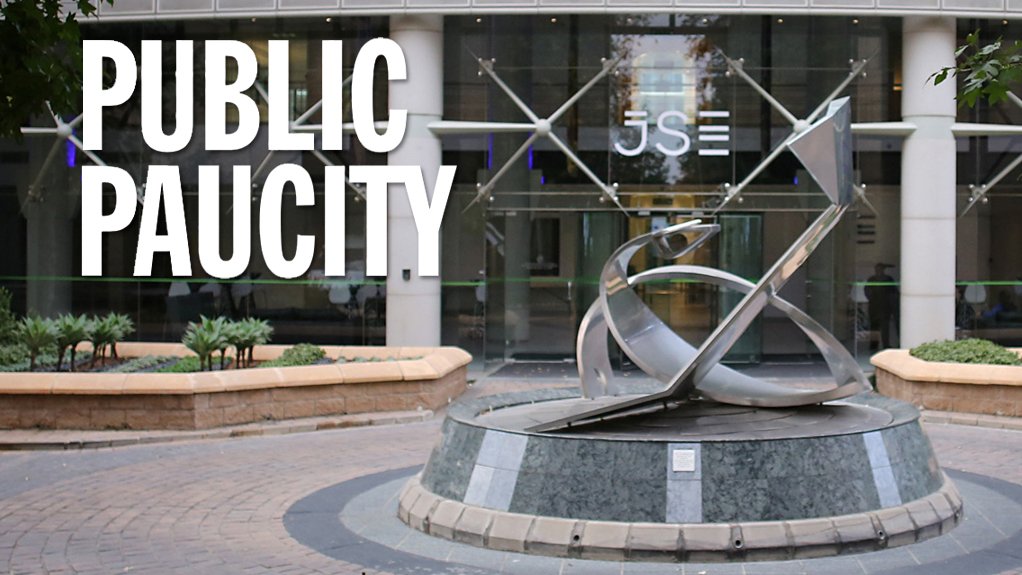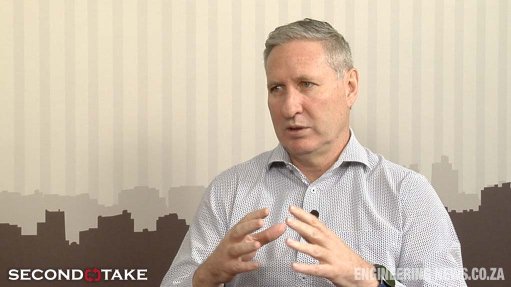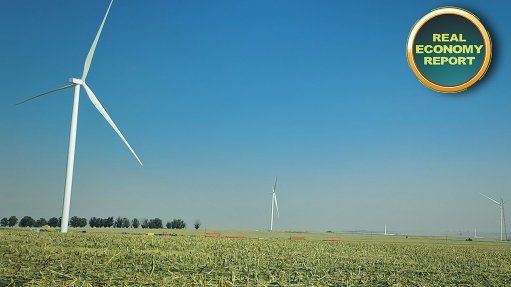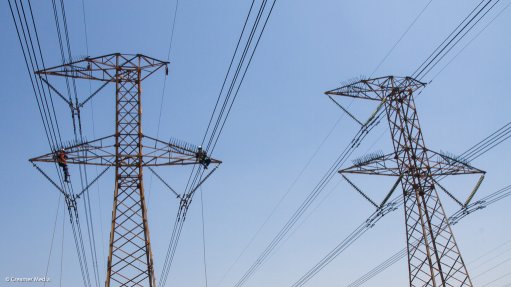Important link between South Africa’s mining industry and its public capital markets is broken
With South Africa needing more listings on its stock exchanges, what can be done to encourage companies in general and junior mining companies in particular to go public?
A lot of the building blocks are in place. South Africa has a stock exchange that punches way above its weight relative to the size of the economy. The country also has about R9-trillion in contractual and other savings, plus a wonderful tradition of being a marketplace for mining companies.
In 1980, when the gold price spiked, the Johannesburg Stock Exchange (JSE) had half of all the world’s mining market capitalisation listed on it.
By 1995, it had 121 mining companies. That number fell to just 49 in 2003 at the start of the last commodities boom and then rose to 71 by 2008. But it has been downhill from there, with only 40 mining companies on the exchange now, after having just lost Assore and gained Thungela Resources.
Admittedly, many are big mining companies and there is still significant secondary trade in major mining shares on the JSE, but what many are most concerned about is why so few new mining companies are listing on the JSE.
“Sadly, I think that’s because there is a massive bias against smaller companies in the way the South African savings industry and thus the market as a whole is now structured,” says AmaranthCX director Paul Miller.
Miller, who spoke to Engineering News & Mining Weekly in a Zoom interview, believes that the best way to start a listings revival is to take advantage of the wonderfully relaxed rules and low costs of secondary listings.
He would like to see the 20 or 30 foreign-listed companies active in South Africa being encouraged to apply for a rapid, low-cost fast-tracked JSE listing.
Companies such as Orion Minerals and Alphamin Resources have already had some success with that approach and Miller believes that it is time for more companies to try it. It is also fortunate that local investors in Orion and Alphamin have done well too.
A start could be made with very significant investor-friendly companies such as Petra Diamonds, Tronox, Jupiter Metals or Ivanhoe Mining. Smaller companies like Terracom, Blue Rock Diamonds and Platinum Group Metals could be of interest too.
It is Miller’s view that the President or the Minister should simply request that these companies apply for secondary listings on a local market. This would be seen as a material contribution to South Africa’s need to improve investor sentiment, develop our capital markets, and help recover post-Covid.
If they could be persuaded to dual-list locally, they would count as domestic companies under Regulation 28 of the Pension Fund Act and be eligible for investment as domestic equities. Retail investors could also buy the shares in rands without having to go through the administrative burden and expense of transferring cash abroad to do so.
JSE Owes Existence to Mining
The issue of the lack of listings goes to the very purpose of a stock exchange. On the Witwatersrand, when George Harrison reputedly discovered the outcrop and mining started, weathered ore was mined on small claims and the gold recovery was easy.
But, very quickly, the early miners got into fresh, unweathered ore and gold recoveries declined. The diggings started getting deeper and deeper, and they needed to raise capital to sink shafts, to consolidate claims and, importantly, to bring out steam engines and stamp mills from Sheffield, in England, to improve recoveries. Other technological improvements soon followed. This, of course, all took time and mining paused, and it was thought that the bubble had burst. It is for this reason that mines started floating their shares, and then trading their shares, often spilling over “between the chains” in Simmons Street, at the start of the JSE.
“So, the JSE owes its existence to primary capital raising for mining. It was because pioneering mining companies were able to raise capital to go deeper and bring out the capital equipment required that South Africa had over a hundred-year history of the greatest gold field in the world,” Miller recalls.
However, as far as can be ascertained, from that very first issuing and trading of shares in the 1880s, South Africa has never had fewer listed mining companies than it has today. Yet, it is still a magnificent mining country, at least as far as operating mines are concerned.
The AmaranthCX database tracks 700 commercial-scale South African mines, which include a considerable number of industrial minerals operations. It does not regard as significant the additional 600 mining rights that the Department of Mineral Resources and Energy statistics show – as they are often unused and dormant or relate to small town quarries or itinerant diamond diggers.
Moreover, the exclusion of industrial minerals, such as silica and clay and dimension stone, leaves about 400 commercial- scale operating mines in South Africa, owned by about 100 mining groups – and yet there are only 40 listed mining companies on the JSE. A not insignificant number of which have no mines in South Africa – Anglo Gold Ashanti, Kore Minerals and Alphamin Resources being examples.
This is so even though the total number of mines is well up, particularly in certain sectors such as manganese.
In 2004, two listed companies owned four manganese mines; there are now 24 manganese mines, with three in development, and the only way the now delisted Assore’s mines can be indirectly accessed by investors is through African Rainbow Minerals (ARM). ARM and South32, whose predecessors owned those same mines 20 years ago, are the only diversified groups that provide insight into manganese mining.
Every single additional manganese mine developed in South Africa since the Mineral and Petroleum Resources Development Act (MPRDA) came into effect in 2004 has chosen not to list on a local exchange.
One of them, Jupiter Metals, which owns 49% of Tshipi é Ntle Manganese Mining, which rightly claims to be a wonderful black economic empowerment success, but it is listed in Australia and not in South Africa.
Unlisted empowered mining investment company Ntsimbintle Holdings, headed by chairperson Saki Macozoma, grabbed the headlines in April by becoming the biggest single shareholder in Jupiter. In acquiring just under 20% of Jupiter, Ntsimbintle is entitled to 47% of the profit from the manganese ore produced by the Tshipi Borwa mine, in the southern part of the Northern Cape’s Kalahari basin. This puts it in a strong position because Tshipi is one of South Africa’s biggest manganese exporters. Ntsimbintle is still only entitled to 37% of Tshipi’s ore, which it trades through Ntsimbintle Marketing & Trading in Singapore.
More Chrome Mines than Ever
South Africa also has more chrome mines now than it has ever had before, including small chrome mining companies.
Because of the new entrants into the coal industry, it also has more individual collieries than ever before, some of which form part of significant businesses, such as Canyon Coal, which is part of the Menar group, Mbuyelo Coal and Msobo Coal.
In fact, now that Seriti has acquired the thermal coal interests of South32, it is likely that more than half of South Africa’s coal is being produced by companies that are not listed, with the recent JSE- and London- listed Thungela Resources being a welcome exception. The consequence is a concerning lack of ongoing public disclosure by these very significant industries, with particularly manganese, chrome and coal having seen net increases in mines but negligible company listings and thus negligible ongoing public disclosures.
South Africa’s policy and legislative environment has broken the important link between its mining industry and its public markets.
Size Bias
One argument is that public investors are reluctant to invest in South African mines, as a consequence of the higher risk of developing mines in terms of South Africa’s regulatory regime.
The other argument is that listing booms followed by delistings are part of a natural 10-year to 12-year cycles. This argument points to the listings boom of 1987, when Investec and others listed, and then the dotcom listings boom in 1999. Then there was the commodities super cycle ahead of the global financial crisis, which was another listings boom, each 10 to 12 years apart.
Against that reckoning, the JSE is due another listings boom now but Miller for one does not think the JSE will see another listings boom because, in the interim, the way South Africa’s savings are managed has fundamentally changed.
There is now a huge size bias in the large funds that manage most of South Africa’s ordinary savings. Pension funds have been consolidated and people are no longer investing in their own names; there are big tax incentives to invest through a retirement annuity or in a pension fund, and even in a unit trust owing to capital gains taxes not being applied until investors sell their units.
If you invest within your own retail investment portfolio, you get taxed on your capital gains as and when they occur. There is thus an implicit incentive for everyone to save through funds, not in their own name.
As a consequence, the funds have become very large.
In fact, the Association of Savings and Investment in South Africa (ASISA) appears to have somewhat captured the policymaking process. That is seen, for example, in the way that tax-free savings accounts were developed to encourage individuals to save, but are effectively required to be managed by an ASISA member at a fee and not by individuals in their own name.
The members of ASISA include 27four Investment Managers Pty, ABSA Financial Services Ltd, Afena Capital Pty, Alexander Forbes Ltd, Allan Gray Pty, Assupol Life Ltd, Coronation Fund Managers Ltd, Discovery Holdings Ltd, FirstRand Life Assurance Ltd, Foord Asset Management Pty, Hollard Life Assurance Ltd, Kagiso Asset Management Pty, Liberty Holdings Ltd, Mazi Asset Management Pty, Momentum Metropolitan Ltd, Nedbank Wealth, Ninety One South Africa Pty, Oasis Group Holdings Pty, Old Mutual, Prescient Investment Management Pty, Prudential Portfolio Managers Pty, PSG Konsult Ltd and Sanlam Ltd.
Savings Shift
The massive shift in savings into these big collective investment schemes, pension funds and retirement annuities has resulted in their significant growth.
Among their common mandate restrictions are that no fund is allowed to own more than 10% of a company and the individual investments in the fund need to be consequential for the fund.
Generally, the rule of thumb there, says Miller, is that any investment that is less than 1% of a fund is too small, resulting in ASISA members not taking a position that amounts to less than 1% of a fund. But these funds are now so big that 1% of the fund is often more than 10% of even a medium-sized company, and therein lies the problem.
They may thus not invest in small companies because of it being either inconsequential for the fund or too consequential in that they end up owning too much of a small company.
“And here we are talking about companies with multibillion-rand market capitalisations,” Miller points out.
At the same time, the Financial Advisory and Intermediary Services (FAIS) Act has changed the very nature of retail stockbroking.
Whereas in the past you would have a discussion with your stockbroker, who could recommend various stocks, discuss stocks and offer new issues of stocks of companies being listed, all of that is now highly regulated.
For compliance reasons, most retail stockbrokers have effectively become wealth managers regulated by the FAIS Act, not brokers – making their money from portfolio management fees, not from trading income. Their compliance processes now require them to have a model portfolio with an approved ‘buy’ list of shares.
A portfolio manager may not include anything outside of that approved ‘buy’ list in a client’s portfolio. Portfolio managers are thus not going to go to all the work of including a small share in the model portfolio when it is inconsequential across the total model portfolio.
As a result, big retail stockbrokers, such as what was formerly Investec Securities – which was very prominent in the listings boom up until 2008 – now offer these model portfolios and no longer play much of a role in getting retail investors into small companies. This applies to all the traditional retail stockbrokers.
In the 1980s, if a company had a public offer of its shares, it would publish an abridged prospectus and an application form in the newspaper and readers would fill out a form and send their cheques to the company’s transfer secretary, which would send them a share certificate and a refund if they were allocated fewer shares than requested. Then, for some reason, it became difficult to get a prospectus registered, and lead arrangers started recommending to companies that they should rather do a private placing to a select group of investors instead.
Until about 2010 a private placing was limited to amounts of R100 000 or more per subscriber – a relatively low amount that had not been increased in decades. What it meant was that there was a massive movement away from having public share offers and prospective retail investors were no longer publicly alerted to new issues of stocks. More recently, the remaining stockbrokers-turned-wealth managers have stopped alerting retail investors to most new issues too – ostensibly for FAIS Act compliance reasons.
“Whenever I ask anyone who has a stockbroking account whether or not they have been told about recent new offers, or has your broker phoned you to ask if you’re interested in participating in a new inward dual listing, or capital raising, I haven’t found anyone who in the last ten years said that their stockbroker has contacted them to participate in a placement or offer,” says Miller.
“Whereas in the 1980s the stockbroker would – and sure there were conflicts of interest in that they encouraged you to participate because they got trading income. When the gold mines were being listed, you would participate. Now, you never even hear from them or of them.
“When I was involved in the capital raisings for junior mining companies before the global financial crisis, we would have to work very hard at our public relations to get past the brokers, to reach the brokers’ clients, so that the clients would then phone the brokers to say that they wanted to participate.
“But now, even that’s been broken. There is no obvious way for small companies, and here I’m looking at R2-billion and R3-billion companies, to raise R100-million or R200-million in primary capital by going to the big funds, because they are simply too small. And you can’t reach the retail investors anymore because the brokers can’t talk to their investors about shares that aren’t in the model portfolio or on the approved buy list,” Miller points out.
Structural Change
There has been this structural change that has disconnected small and mid-tier companies from investors. This is not specific to mining companies – it is for any company.
“That structural change has seemingly been wrought by the compliance requirements of the FAIS Act, which I’m not saying is necessarily really wrong, but it is a structural effect and we need to have an alternative way for small and mid-tier companies to make their pitch to investors with a fully registered prospectus and a fully regulated process. There has to be a way to reach out to get to smaller investors, and at the moment that doesn’t exist,” says Miller.
Just on the basis that it is 10 to 12 years since the last listings boom, the country should be due a post-Covid listings boom. If the macro economists are correct and there is a natural frequency of sentiment and economic factors – with listings booms followed by delistings booms, followed by listings booms again – a listings boom is due.
Unfortunately, in South Africa the frequency is too long for the experience to stay in the financial services industry so it has to be relearnt every 10 to 12 years. But the structural change in the period is poised to hold it back.
The one outlier to the changing role of stockbroking firms is the wonderful success of EasyEquities, which has had a million people sign up, of which a few hundred thousand are active.
EasyEquities is actually a growing retail stockbroker. But it is not apparent that they are going to be able to provide access to new issues of shares for investors. Whereas in the dotcom boom stockbrokers associated with private banks would even lend money to an investor to ‘stag’ a new issue because markets were hot; new issues were often massively over-subscribed; and clients wanted to apply for more shares than they could afford to cater for inevitable allocation cutbacks – only to immediately sell the shares into a rising market.
That kind of activity no longer exists and the retail stockbrokers that are part of the private banking divisions of major banks can no longer engage in broking in that sense because they are now wealth managers and financial planners and they have got a fiduciary responsibility to individuals across a massive compliance layer.
They may no longer phone to ask their clients if they want to “take a punt” on a speculative new listing as this is seen as being noncompliant.
“If we are due a listings boom, we’re not ready for it,” says Miller.
The income of one major stockbroking firm he went to see has gone from 85% trading income ten years ago and 15% portfolio management income, to the reverse.
“When people say, ah, it’s just cyclical, it’ll come back, it always does, I say no, there has actually been a structural change. People are investing in unit trusts and financial advisers are putting them into structured portfolios. There are no longer many direct investors,” Miller adds.
11 Companies Manage 90% of Savings
An estimated 90% of all non-banking savings in South Africa is now managed by only 11 institutions. One of them is the Public Investment Corporation (PIC) of South Africa, which manages in the region of R2-trillion.
Now, if a R1-billion market-cap junior mining company went to the PIC to raise R50-million or R100-million for a drilling programme for exploration, the PIC would unlikely give it the time of day because that size deal would be so inconsequential in its life.
A very interesting capital raising taken to the PIC four years ago for a single-project company was turned down solely on the basis that the PIC does not invest in preproduction mining companies.
This means that the biggest fund manager in South Africa, in what was once the greatest mining country in the world, would not even look at a developing mining company that is preproduction. So South Africa’s biggest single source of capital is not available for preproduction projects, which is just when projects need capital. It is self-evident that secondary trade in a company’s shares builds nothing new – primary capital raising is required to build mines, but the PIC, at least in that instance, could not be bothered to even consider the merits of the investment.
There are also no tax incentives to invest in junior mining companies and it appears that it is the ASISA members, who won’t or can’t invest in junior mining, who seem to disproportionately benefit from any tax incentives provided to savers by the National Treasury.
“The idea that you can’t manage your own equity portfolio within a tax-free savings account wrapper is straight rent-seeking by the institutional savings industry,” argues Miller.
The way a tax-free savings account works is that any number of instruments can be put into it but that it has to be managed by a third party.
If you want shares, you have to invest in a unit trust, and a unit trust has fees taken out of it by a member of ASISA, who represents those large institutions. ASISA is the same organisation that lobbied against the relaxation of exchange controls on Exchange Traded Funds. ASISA denies it lobbies at all.
“They are completely dominant, they’ve clearly got the ear of National Treasury, and they rent-seek flat out. They don’t want you to be able to manage your own share portfolio; they want you to have to pay them a fee.
“Remember, the more regulation and compliance there is, the more it benefits big players and disadvantages small players because they’ve got the capability to manage the compliance requirements.
“So, they absorb the cost of compliance, and it kills the small players and new entrants. It concentrates our industry and it denies small companies access to capital because small companies need a diversity of investors.
“We’ve basically destroyed our retail stockbroking industry as a source of primary capital through the FAIS Act and through these benefits that accrue to the large players, and now we wonder why we’ve got half the number of listed companies that we used to have,” says Miller.
The institutions have sucked in all the savings so instead of having 40 or 50 retail stockbrokers with offices in places like Pietermaritzburg and Port Elizabeth and Bloemfontein, where anyone with discretionary savings could have a retail stockbroking account advised by a stockbroker, which meant they could take a view on small and mid-tier companies and participate in new issues.
Where the chickens come home to roost is that small companies are no longer coming to the exchange
Every policy intervention that National Treasury comes out with seems to benefit ASISA members at the expense of diversity and smaller players.
"There's a structural consequence to that. If you allow the money to concentrate in big funds, you exclude small companies and new entrants from access to public market capital. More than that, they’ve also bought up all the stockbrokers and turned them into wealth managers," says Miler.
Stockbrokers no longer serve to raise primary capital for new projects. But there are some interesting developments.
Technology is going to play a role although there has not been that response yet.
“I’m working on something and there’s also the likes of EasyEquities, which is the Capitec equivalent in the stockbroking space. So, there is some hope but we need disrupters to come through to be able to bridge the gap between small companies that need capital and investors, be they corporates or trusts or individuals,” he adds.
Big Tax Benefits
But there is a consequence to allowing these big companies to just get bigger and bigger and have the benefit of tax incentives flow to them. The concentration means that small companies are excluded from public markets.
What it has also done is it has opened up the gap for alternative sources of private capital to fund mining companies. Mines have been built in the manganese, chrome and coal sectors, and these mines are getting capital for development, just not public market capital.
Mainly it is coming from the backward integration by commodity trading houses and from big service providers, like mining contractors. A small coal mine will , for example, be funded by a combination of the contractor who gets the mining contract offering extended credit terms, and the offtaker of the commodity, who might make a pre-payment against an offtake contract for the coal itself.
It is not in the interests of the large financial institutions for individuals to have their own stockbroking accounts; there has been no lobbying success in support for incentives for junior mining; and there is also no lobbying in support for more diverse, smaller companies on the stock exchange. It seems the powerful interests are only interested in the top 60 or so companies, which goes against the very essence of encouraging new entrants coming to the public markets.
It has been recognised in the Department of Trade, Industry and Competition that they need to try and limit corporate concentration but it does not seem to be recognised in the National Treasury that if tax incentives are given to savers and regulatory compliance is made very difficult and expensive, it benefits the big players who just get bigger and ultimately it results in a structural disadvantage for smaller companies of all kinds, adds Miller.
The JSE is clearly no longer a source of primary capital, which is the very reason for the existence of a stock exchange.
“When you hear the CEO of the JSE being interviewed, she talks about how massive the total market capitalisation of the JSE is. The market capitalisation of the JSE is 17th in the world but our economy is only 33rd so therefore we’re doing well. But those massive companies aren’t here for primary capital; they are all here for secondary trade, which does not grow the real economy,” says Miller.
What Must be Done?
Firstly, inward dual listings on to the stock exchange must be encouraged to double the number of mining companies on the exchange. The JSE has done its part here – fast-track secondary listings on the JSE are low-cost with a light regulatory touch.
That will result in more analysts covering mining companies. Foreign companies that dual-list will be included as domestic shares in local pension funds..
Examples of the foreign companies that should be encouraged to dual-list include Petra Diamonds, Blue Rock Diamonds, Ivanhoe Mines, Platinum Group Metals, Terracom, Bushveld Minerals, Jupiter Metals, Diamcor Mining, and Tronox. Their listings would help to sustain specialists in the financial services sector. Mining engineers with MBA degrees could become analysts, and it might attract more interest into mining companies amongst retail brokers such as Plus500 or EasyEquities or others.
That would be low-cost and would not need new legislation. All that is needed is for a senior politician to literally ask those companies to do it as a contribution to South Africa’s post-Covid recovery.
What about Mineral Resources and Energy Minister Gwede Mantashe phoning up the chairperson of each one of those companies and asking, please, as a contribution to South Africa’s recovery, the country wants to get mining going on our stock exchange and would they please come and see if they could get a low-cost, fast-tracked secondary listing with no extra regulations?
The dual-listed foreign companies would remain subject to their primary stock exchange but South African funds could then be invested in them as domestic companies.
While there is no requirement in the Mining Charter for mining companies to contribute to the development of South Africa’s financial services sector, mining companies are asked to contribute to so much else.
Those that do choose to list on the JSE should benefit from some sort of offset and mining companies could receive some points in the charter for being a local South African listed company.
Flow-Through Shares
Although South Africa was promised flow-through shares by former Finance Minister Trevor Manuel when he was in office, no progress has been made in introducing them, even though a mining economy of a country like Canada has benefited enormously from having flow-through shares that incentivise exploration.
Some see in the actions of the National Treasury an antipathy towards sector-specific incentives. It has withdrawn its own scheme under Section 12J of the Income Tax Act and has been cutting tax incentives across the board. What the Treasury would seemingly rather do is reduce overall corporate taxes, which it regards as being simpler for them in its bid to stave off special interest groups.
“Flow-through shares are simply not going to happen. We just need to accept that. But we could have plenty of additional listed companies on the JSE and the AltX if we just asked them to list, because it costs the companies very little,” says Miller.
“If there are enough of these dual-listed foreign companies and they can get enough attention, their share prices in South Africa can even run ahead of the share prices in other countries.
“A case in point is Orion Minerals, the share price of which did just that; it ran ahead of its Australia price and has attracted some South African institutions. It’s a foreign company with South Africa interests and in which the South African institutions may invest,” Miller adds.
Democratic Republic of Congo tin-mining company Alphamin Resources, which has tripled its share price since it listed on the JSE in 2017, has no assets in South Africa. Alphamin’s headquarters are in Mauritius and it is primarily listed in Toronto. At one stage, the share price here ran ahead of Canada too.
The dual listing of Aim-listed Namibian tin-mining company AfriTin could also provide investors with exposure to the high- flying $30 000/t tin price.
“It’s a chicken and egg situation. If you do not have enough companies, there are also too few analysts and specialists and listings remain illiquid,” adds Miller.
South Africa is expected to have a post-Covid boom in one form or another, and a mining company listing on the JSE every second week for a year, even if these are secondary listings, will help the economy lift its head.
Then, these secondary listings could be followed by as many primary listings by the many unlisted companies that are large enough to be listed.
In manganese, companies that could go public include Ntsimbintle, UMK (with the presence of Chancellor House/African National Congress (ANC) on the share register), Kalahari Manganese, in which the Industrial Development Corporation (IDC) is invested, and Kudumane Manganese.
In chrome, listing candidates would include Samancor Chrome, Clover Alloys and Sefateng Chrome.
In industrial minerals, the limestone, salt and soda ash interests of the BUD Group could list along with Afrisam Cement, in which the PIC is invested.
In coal, Seriti, Msobo Coal, Mbuyelo Coal, Beryl Group, Canyon Coal/Menar and a spin-out of HCI Coal from Hoskens could follow Thungela, which earlier this year went public with a primary listing on the JSE and a secondary listing in London.
In platinum group metals, Sedibelo Platinum and Siyanda Bagatla Platinum could list.
In copper/magnetite, Palabora Mining Company could list.
Moreover, the government could list AEMFC, a Central Energy Fund entity, and Foskor, in which the IDC is invested.
The economic transformation committee (ETC) of the ANC supports the listing of mining companies on the JSE in a 30-page document released in July last year, which states that South African retail investors willing to invest in mining exploration should be incentivised, as is the case in other mining jurisdictions.
In order to translate South Africa’s comparative resources into a competitive advantage, the ANC ETC document states that there is a need to introduce robust junior mineral exploration and to build strong supportive mining supply and services sectors.
The ANC ETC document acknowledges the need to place the mining industry on a path of competitiveness and long-term success.
Article Enquiry
Email Article
Save Article
To advertise email advertising@creamermedia.co.za or click here
Comments
Press Office
Announcements
What's On
Subscribe to improve your user experience...
Option 1 (equivalent of R125 a month):
Receive a weekly copy of Creamer Media's Engineering News & Mining Weekly magazine
(print copy for those in South Africa and e-magazine for those outside of South Africa)
Receive daily email newsletters
Access to full search results
Access archive of magazine back copies
Access to Projects in Progress
Access to ONE Research Report of your choice in PDF format
Option 2 (equivalent of R375 a month):
All benefits from Option 1
PLUS
Access to Creamer Media's Research Channel Africa for ALL Research Reports, in PDF format, on various industrial and mining sectors
including Electricity; Water; Energy Transition; Hydrogen; Roads, Rail and Ports; Coal; Gold; Platinum; Battery Metals; etc.
Already a subscriber?
Forgotten your password?
Receive weekly copy of Creamer Media's Engineering News & Mining Weekly magazine (print copy for those in South Africa and e-magazine for those outside of South Africa)
➕
Recieve daily email newsletters
➕
Access to full search results
➕
Access archive of magazine back copies
➕
Access to Projects in Progress
➕
Access to ONE Research Report of your choice in PDF format
RESEARCH CHANNEL AFRICA
R4500 (equivalent of R375 a month)
SUBSCRIBEAll benefits from Option 1
➕
Access to Creamer Media's Research Channel Africa for ALL Research Reports on various industrial and mining sectors, in PDF format, including on:
Electricity
➕
Water
➕
Energy Transition
➕
Hydrogen
➕
Roads, Rail and Ports
➕
Coal
➕
Gold
➕
Platinum
➕
Battery Metals
➕
etc.
Receive all benefits from Option 1 or Option 2 delivered to numerous people at your company
➕
Multiple User names and Passwords for simultaneous log-ins
➕
Intranet integration access to all in your organisation
























